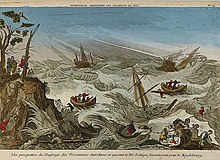

A zograscope is an optical device for magnifying flat pictures that also has the property of enhancing the sense of the depth shown in the picture. It consists of a large magnifying lens through which the picture is viewed. Devices containing only the lens are sometimes referred to as graphoscopes. Other models have the lens mounted on a stand in front of an angled mirror. This allows someone to sit at a table and to look through the lens at the picture flat on the table. Pictures viewed in this way need to be left-right reversed; this is obvious in the case of writing. A print made for this purpose, typically with extensive graphical projection perspective, is called a vue d'optique or "perspective view".
Zograscopes were popular during the later half of the 18th century as parlour entertainments.[1] Most existing ones from that time are fine furniture, with turned stands, mouldings, brass fittings, and fine finishes.
According to Michael Quinion, the origin of the term is lost, but it is also known as a diagonal mirror, as an optical pillar machine, or as an optical diagonal machine.[2]
In Japan, the zograscope became known as 和蘭眼鏡 (Oranda megane, 'Dutch glasses') or 覗き眼鏡 (nozoki megane 'peeping glasses'), and the pictures were known as 眼鏡絵 (megane-e, 'optique picture') 繰絵 (karakuri-e 'tricky picture').
- ^ Permutt, Cyril (1976). Collecting Old Cameras. New York: DaCapo Press. pp. 23, 27. ISBN 978-0-306-70855-8.
- ^ Worldwidewords.org